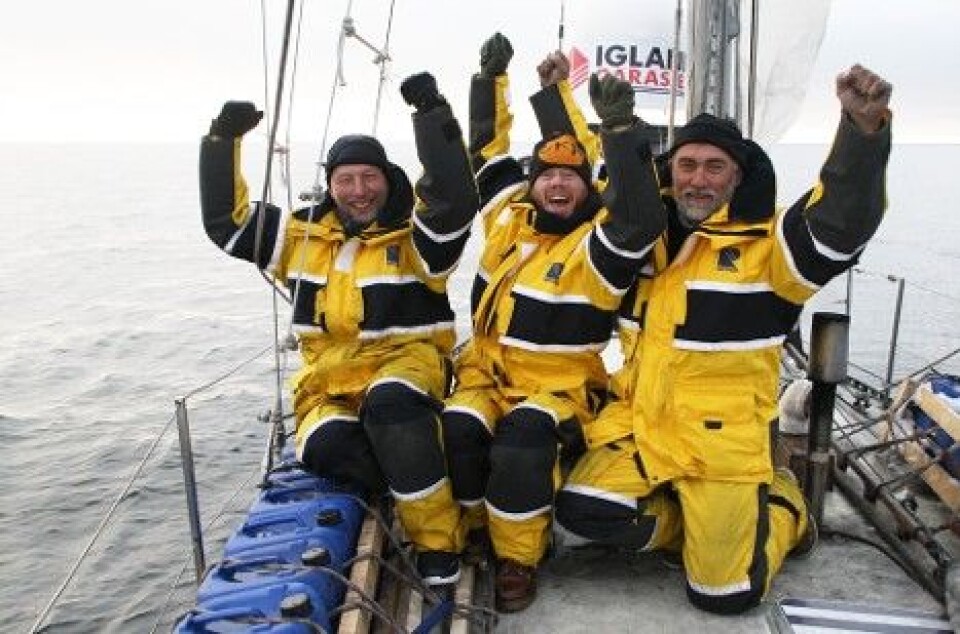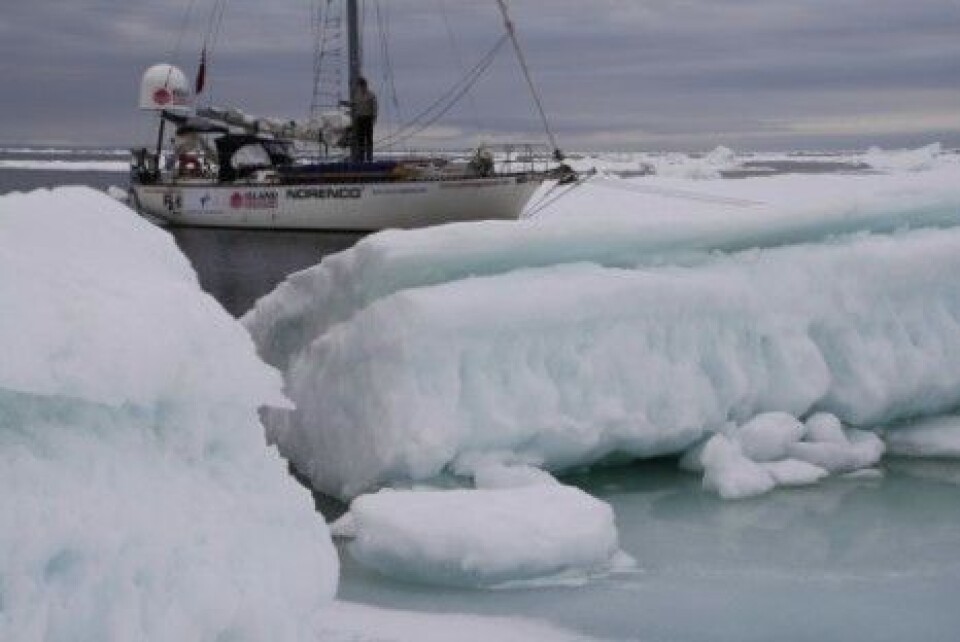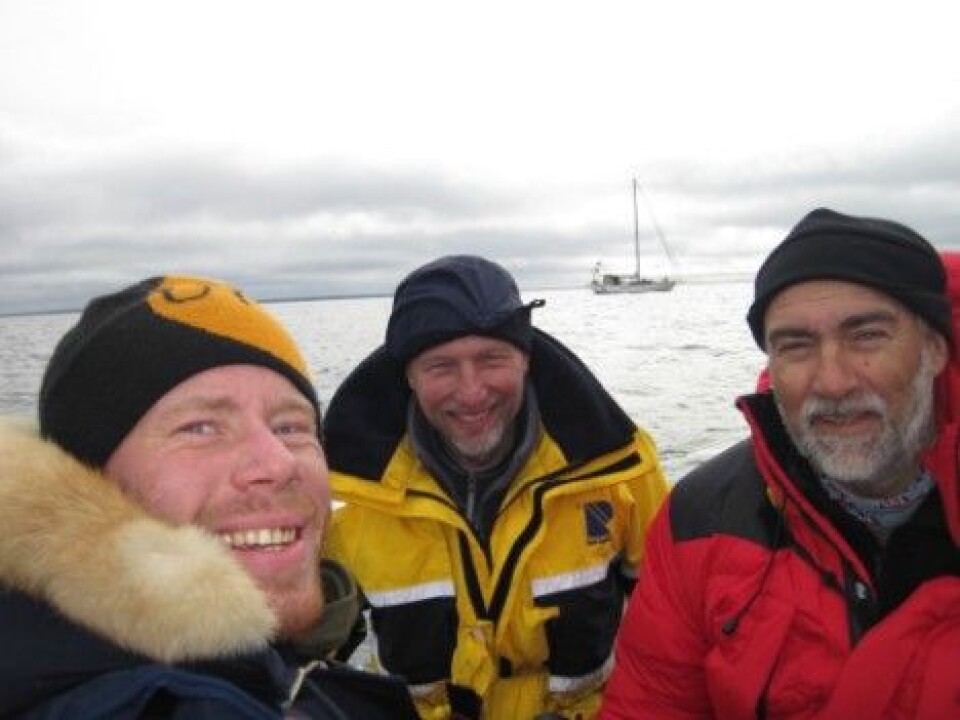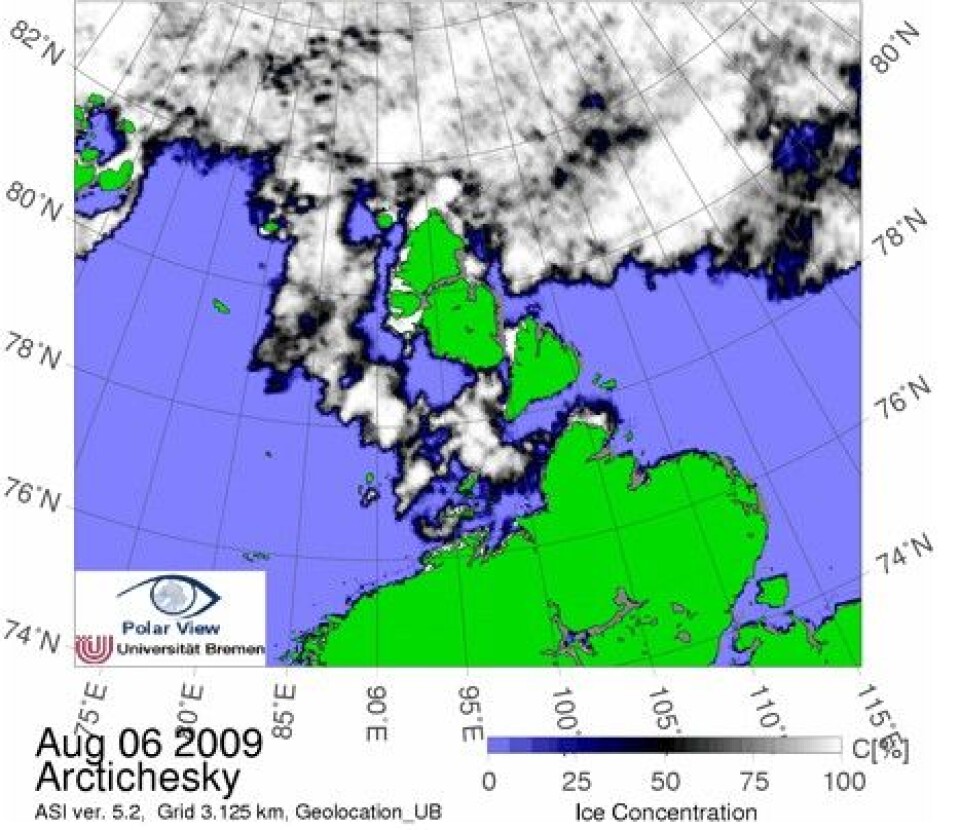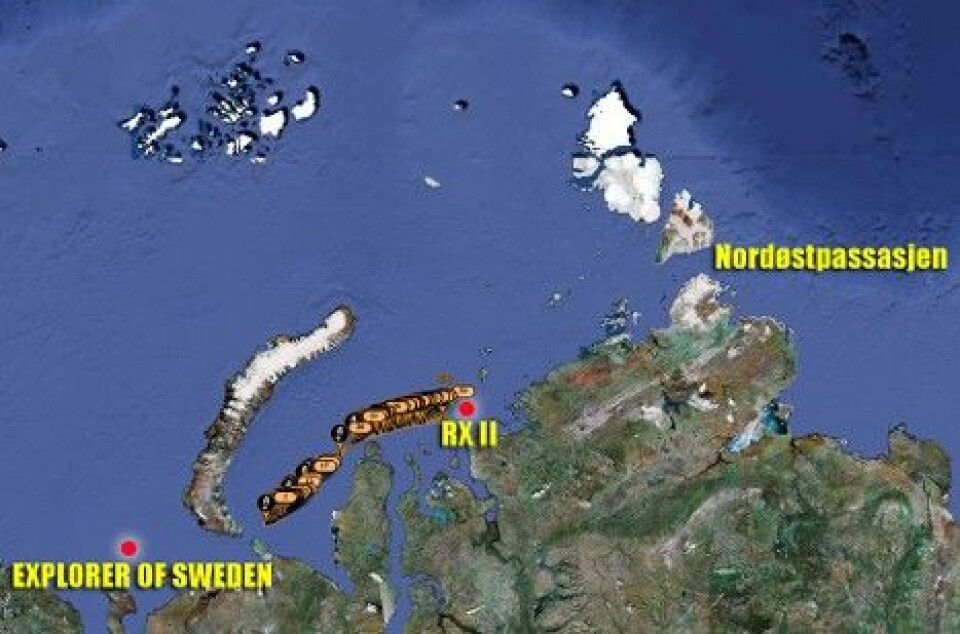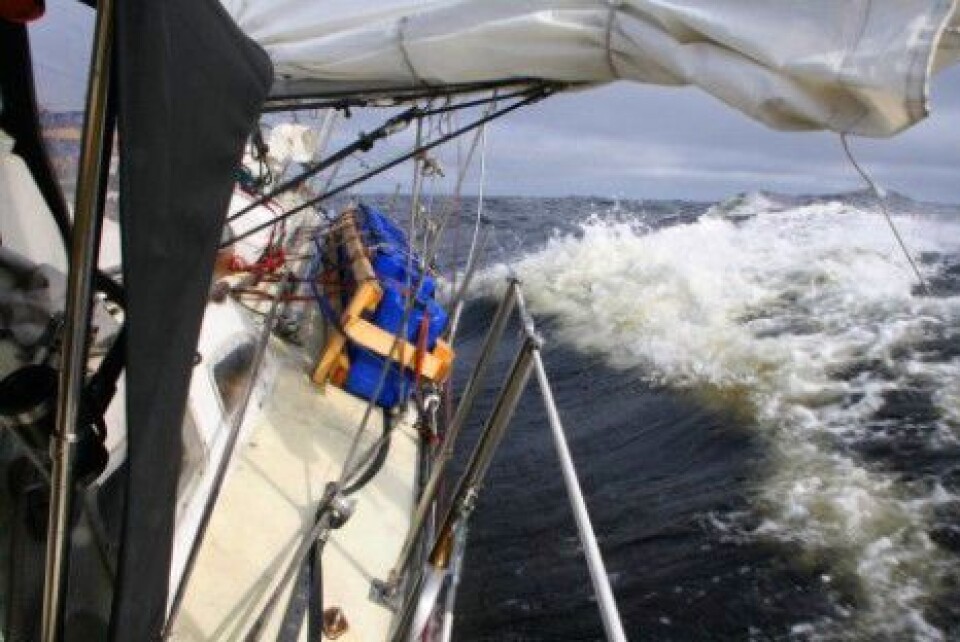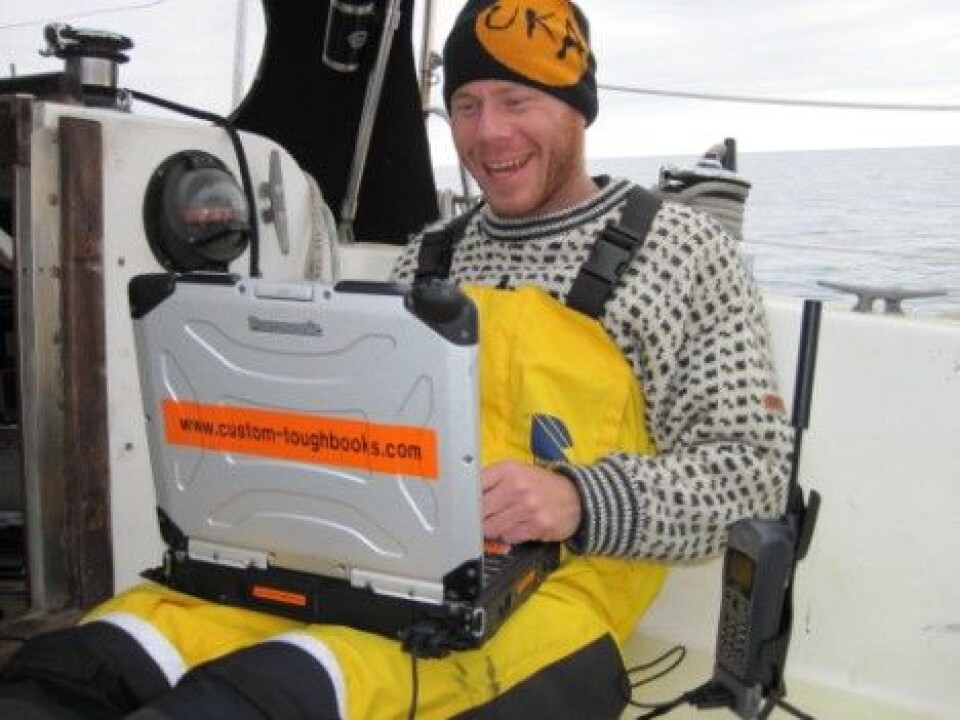RX II News in english
RX II Not Quite Through the North East Passage Yet
To paraphrase a Norwegian proverb, they may well have sold the hide before the bear was even sighted, and they are still not through bottleneck number two," is ice forecaster Knut Espen Solberg of Det Norske Veritas` sobering comment to our panegyric news that RX II has made it through the North East Passage.
– "Before they reach Point Barrow, Alaska, they have at least 10 days of sailing ahead, in waters that are not exactly notorius for sunshine and fair weather. The North East Passage has one more bottleneck after the one they just passed through, and it is by the New Siberian Islands," Knut Espen Solberg of Det Norske Veritas points, who assists the RX II-sailors with ice forecasts and advise, points out.
"VEGA, with the Swede Adolf Erik Nordenskiöld, got stuck in the pack ice at Cape Tjeljuskin on August 28, 1878 and had to spend the winter in the ice. This is due West of Cape Chelagskij just a few days` sailing from the Bering Strait," he warns.
"This year, though, there does not seem to be a lot of ice in the area, so it should be OK. But still... talk about selling the hide before the bear has even been sighted... Objectively, RX II is now half way through the North East Passage, but they have left the statistically greatest challenge behind them," says Knut Espen Solberg.
Rolf Erik Nordenskiöld was the very first to sail through the North East Passage. Roald Amundsen was number two when he sailed through with MAUD in 1918-20.
"Both these boats had sail and were Scandinavian, so to announce that RX II is the first Scandinavian sailboat through the North East Passage is not entirely correct, either," he continues.
But they will be number three of the Scandinavian boats if they make it - and definitely the smallest.
VEGA was 43 meters long and had three masts. The ship also had a 60hp steam engine.
MAUD was 36.5 meters long, had a beam of 12.3 meters and a 4.85 meters draft. It had a 240hp semi diesel engine.
RX II is a mere 10.97 meters, has a 3.08 meters beam and 1.7 meters draft. Below decks, they have a 30 hp engine.
------
Saturday, August 15, 2009
First Scandinavinan Sail Boat Through the North East Passage
As the first Scandinavian sail boat ever, RX II has now passed through the North East Passage! They exited the ice on Friday, August 14, and have now set course towards the North West Passage. If they are able to traverse that passage, too, Trond Aasvoll, FInn Andreassen and Hans Fredrik Haukeland will have made their place in history.
RX II is probably also the smallest sailboat to ever sail the North East Passage.
They have now entered the large Laptev Sea, and will in approx. 10 days reach Point Barrow, Alaska and the entrance to the North West Passage.
- They now have a fantastic opportunity to make it all the way rond as the first ever, since the ice in the North West Passage is steadily dissolving, says Lars Ingeberg, the owner of RX II.
He can also inform that the boat`s original owner, the American Eric, is closely following RX II`s voyage.
Eric is sending mail to the "whole world", and is incredibly proud of the crew on board RX II and "his" boat, says Ingeberg.
Sailing through the North East Passage gave numerous unnerving challenges. Here is the crew`s own account:
Hooray! We made it!!
An incredible relief to exit the ice! After a long and hard battle against the elements.
We have been quite unfortunate with the ice conditions, so the last few days have been tough. There has been more ice than expected, gale and dense fog and snow. And all the time curious polar bears wandering about. But they have been the least of our problems. They were seldom closer than a few hundred meters, and when they came too close it was ususally sufficient to yell at them and they would withdraw. The ice was our real problem.
In order to avoid beng screwed down by the ice, you need to be constantly moving. When you see a large floe drifting your way, you must have an open patch of water to move to. If not, the boat will be swiftly crushed. The forces are unbelievable!
When fog and drifting snow reduces the sight to a mere 200 meters, you may quickly loose overview and find yourself locked in. And that was what happened with us a few times. All the nearby leads close up and you are caught in a "lagoon", surrounded by dense, moving packs of ice. When the lagoon then starts to shrink, and one ice floe after another comes drifting with the wind and packs up inside, it is critical. But by a combination of hard work, some luck and good cooperation we got out of there in one piece.
The ice was laying approximately up to the Bolsjevik Island, so we sailed as far north as 78 deg, 14 min N in order to pass it with a margin.
In addition to the large compass deviation, there are numerous strong, magnetic fields around this entire area, so both the magnetic compass and the gyro compass are constantly going crazy. They may change by as much as 30 degrees in an instant! Luckily, www.custom-toughbooks.com have lent us two water- and shockproof laptops with built in, powerful GPS receivers. We can keep them in the cockpit no matter what the weather, so we have always been able to find the right direction. Electronic maps with tracking gave us an indication of where we had previously tried to find openings, so that we avoided sailing into the same dead ends again.
We have heard that Ole Skinnarmo is waiting out the weather and ice conditions, and that is probably sensible. We would not wish for him the same conditions we have had!
Thus, we say farewell to the Kara Sea as the Laptev Sea welcomes us with a nice little gale in the right direction. We are happy to be saling again!
Finn Andreassen
------
Tuesday, August 11, 2009
-------
Fantastic Position in Relation to the Ice
Knut Espen Solberg has analyzed the ice conditions for RX II and can report good conditions for the three polar venturers.
You are now in the position where the ice conditions are at its best. You have about 60nm to go until you are done with the most heavy ice. Judging from the ice maps, it seems like you will meet some dense areas the next 30nm, and then the ice will slacken off. It seems like the open water near shore is best 4-6nm offshore, but you will be in a better position to judge that than we who are stuck at home in front of our PC.
The next few hours will be more or less dead calm. There is a north-eastern gale approaching Wednesday night. That gives you a fair margin to get out of the ice before the wind picks up.
The gale also represents a form of security, however strange that may seem. The wind will be more or less parallel to shore. Due to the Coriolis force, the ice will move to the right of the wind, which will help maintain that open stretch of water near the shore.
If the ice should thicken, I would not recommend that you venture too far out (west). It is better to hug the shore, perhaps find an islet, bay or similar "safe haven" and wait it out. The water will open up near the shore again - it is just a matter of time, while the drift ice may not necessarily open up again in the near future.
The best thing you can do is what you are doing just now - go for it!
------
Monday, August 10 2009
After a long time at sea, we decided to take a full day`s rest in a sheltered bay that we had spotted on the map. A stopover also fit in well with respect to the weather and the ice. We are actually a little ahead of schedule regarding the ice conditions, we have to give the southern wind some time to clear away the ice before we can get through. Besides, it gave us a chance to perform a little periodic maintenance on RX II. Oil and diesel filters were changed and various equipment checked. The water tanks were filled with water from a river that runs down from the Siberian Taiga. And it was wonderful to stretch our legs!
We inflated the dinghy and made for shore, eager for adventure. And we were not disappointed! It turned out that there was an abandoned trapper station at the end of the bay. And there were a lot to see. Like an untouched museum! We found nothing to suggest that anybody had been here after the station was abandoned, and that gave us an awesome impression of what life must have been like in such a tough and inhospitable place. Don`t think the old trapper`s life should be romanticized too much. The graveyard bore witness of a hard and brutal existence.
After having looked around, we found fresh reindeer tracks on the beach. And right beside them, just as fresh, some bear tracks. After that, we stayed close to Hans Fredrik who was carrying the rifle. When hunger finally got the better of us, we returned to RX II for a delicious dinner. Ham steak with brown gravy, sauerkraut and mashed swede. It`s an unusual feeling to be able to sit around the cabin table and eat while not having to hold on to both plate, cup and yourself!
Hans Fredrik and I then went on a small dinghy-expedition up a river to try the fishing and at the same time fill the water cans with fresh water. We were able to penetrate several kilometers into the Siberian Taiga. A wonderful landscape! Especially for someone from southern Norway, it was strange to see how the rocks rise up from the permanently frozen ground. And it is the same way with coffins. We happened upon yet another graveyard, and the coffin was on its way up. Covered with moss and beautiful, small yellow, blue and white flowers, and the magnificent view over the river, it made a strong impression.
We eventually filled our water cans, but never saw any fish. Anyways,+ Hans Fredrik may now boast that he has been fly-fishing in Siberia!
Tomorrow we`ll get started on the ice and the North East Passage proper!
Finn
---------
A Promising Forecast, But Keep Close to Shore
On August 5th, EXPLORER OF SWEDEN left Murmansk. Thus, the "race" around the North Pole has started. RX II has a 4-5 day lead...07.08.09
Swedish sailor Ola Skinnarmo and his crew aboard EXPLORER OF SWEDEN cast off from Murmansk on Wednesday, August 5th, and set course for the North East Passage. RX II has a competitor approaching from behind.
Even though the Norwegians Trond Aasvoll, Finn Andreassen and Hans Fredrik Haukland have a good lead, there are no guarantees that they will be the first to reach the Passage. Nor is it given that the North East Passage will be open and free of ice.
David vs. Goliath
This is a match of David against Goliath.
The underdog, David, is RX II. A 10.97 meters, long keeled boat built in 1977.
EXPLORER OF SWEDEN is the Goliath, 18.50 meters long. A mast that soars 10 meters higher and a total sail area of 425 square meters. A modern boat that is specially equipped for sailing in Arctic waters.
RX II`s budget is around NOK 50 000, EXPLORER OF SWEDEN`s budget is counted in millons.
Fast enough?
This isn`t a question of whether EXPLORER OF SWEDEN is faster than RX II, but whether they`re fast enough to catch up with RX II before the first crux on the route around the North Pole: The North East Passage.
The next question is whether the North East Passage is navigable or filled with ice, and eventually which boat will find the passage through it. The ice forecasts are good and promise a quick passage. Both RX II and EXPOLRER OF SWEDEN get their ice forecasts from the same source, Knut Espen Solberg of Det Norske Veritas.
Gale From the North
The last report from RX II reports that they are now sailing in a northern gale, and they are finally experiencing what arctic saling is all about. It is freezing cold, but quality sailing clothes and a little heat in the cabin helps them keep warm.
And they`re not complaining, but look forward to the North East Passage, where not many vessels have sailed before them, with a mixture of excitement and awe.
North West Passage Next
When they`ve passed the North East Passage, RX II will set course for the North West Passage. If they can get through it before winter sets in, they weill be the first sailboat in the world to negotiate both passages in the course of one short season.
The is, if EXPLORER OF SWEDEN doesn`t overtake them...
The Swedes have not made any public statement that they will attempt the North West Passage, but the crew of RX II has a strong feeling that Ola Skinnarmo & Co will not let the opportunity pass, should they have a fair chance of making it through.
And according to Knut Espen Solberg, chances are very good this year.
And should any of them actually manage to circumnavigate the North Pole in only one season, it is but another piece of evidence that the conditions in the Arctic are indeed changing, and that global warming influences what happens in the polar regions - with the implications that may have for life on this planet.
------------
A Gale from the North
Although the sailing is excellent, and we are wolfing down the miles, there is little to see here in the way of animal life or anything else, compared to the Barents Sea. Not even the Northern Fulmar, that steadily followed us, is to be seen now.
The sea doesn`t seem to contain a lot of nutrients and has a dull, marshy-brown color. Our observations the last three days have been a small flock of Terns, an Arctic Skua, a small tree and a small pallet. We`re reckoning that there will be more life again as we push further North and East. We`re hoping to see Walrus among the islands to the North in a few days. The Walrus in this area is reported to be larger than the ones around Svalbard and Greenland.
What`s getting our attention right now is two large ships to starboard. We first feared that they were navy ships, but they now appear to be clam ships of smoe kind. We are now 13nm off shore, and the depth is a mere 20 meters. In the position of the ships, it can be no more than 10 meters or so. These are the first vessels we`ve spotted in the Kara Sea. We`re reckoning we`ve given them something to talk about, too. A sailboat is not an everyday sighting in these waters!
Satellite coverage is getting more and more sketchy. This is especially noticeable on the satphone and tracking. We`re just too far north (73 degrees N), and since we`re at least going as far north as 77 deg 44 min, we`re a little concerned about how much we will be able to transmit.
But we promise to try.
------
05.08.09
Gennaker Sailing and Fashion Show
We had some great gennaker sailing yesterday afternoon and into the night! We`re making good speed and not using any diesel
But we`ve noticed that the watches are steadily getting chillier, down to 4 degrees C now. And to quote Nansen: "The cold is somehow colder here in the Arctic than back home in Christiania [Oslo]." It is quite cold when you`re exposed to the wind, even though the sun shines from a cloudless sky.
We`re adapting to the situation the best we can, and have now drawn a lee cloth around the cockpit to shelter us from the cold wind from the north. We`ve found our warmest clothes, and tried them on in different configurations. A downright fashion show in the cabin. Color combinations and style may not be the most important things up here, but then again we won`t ave any more fun than what we`re able to make ourselves.
Trond has been awarded the Bodybuilder Prize for his enormous down jacket.
This is the ninth day at sea. Morale is high. We`re getting enough sleep, enough food and the cabin is warm and cozy. The food merits a mention on its own. We`ve come to realize that we have really victualled for cold weather sailing: Dinners are practically overflowing with bacon and reindeer fat, while our level of exercise is rather modest. That`s the way to build an isolating layer of subcutaneous fat!
----
03.08.09
Dream Conditions, North Pole to Port

